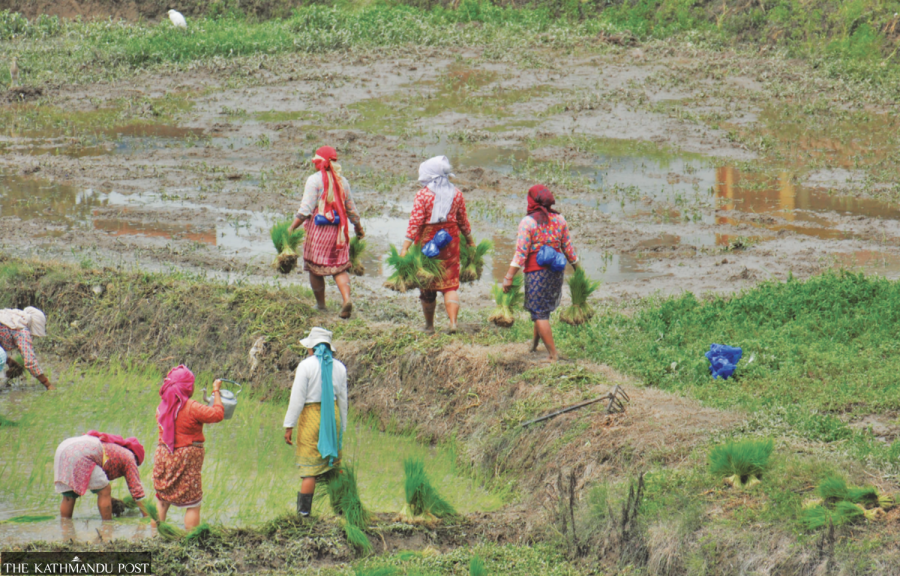Money
Minority rule raises minimum support price for paddy
As of Sunday, transplantation has been completed on 38.6 percent of Nepal’s 1.39 million hectares of paddy fields.
Post Report
The government last week raised the minimum support price for paddy by more than 6.5 percent for the harvest of the next fiscal year, 2023-24, soon after the Pushpa Kamal Dahal-led administration was reduced to a minority.
This was the second time the government fixed the minimum support price during the paddy transplantation period.
The Ministry of Commerce and Supplies tabled the proposal to increase the price, which was approved by the Cabinet meeting on July 4.
The government decided to increase the minimum support price of common paddy to Rs3,580.62 per quintal (Rs35.80 per kg), up 6.50 percent.
Similarly, the floor price for ‘mota dhan’ has been increased to Rs3,410.51 per quintal (Rs34.10 per kg), up 6.64 percent.
The minimum support price is the lowest legal price that farmers receive for their harvests. The government does not fix the floor price of fine paddy.
A minimum support price is an intervention by the government to protect farmers against sudden slumps in market prices. It is the rate at which the government buys farm produce when no other buyers are in the market.
Usually, it is announced in time for farmers to make their production plans before the beginning of the planting season. Under the scheme, the government has to buy a certain amount of the total paddy harvest.
In 2012, the government announced the resumption of the policy of fixing the minimum price following complaints that middlemen had been determining the market rate.
Until 1999, the minimum support price for paddy and wheat would be announced regularly.
According to reports, the practice was fully abandoned that year after the government launched the 20-year Agriculture Perspective Plan.
Even when the minimum support price was announced, it was irrelevant as it was set well below the projected market price to protect the government from having to buy farm products should prices tumble.
Moreover, reports said that even when support prices were announced, it was not done in time.
The policy was irregular.
In 2016-17, the minimum support price was announced in mid-November. In 2017-2018, the Cabinet sent back the supplies ministry's proposal.
In 2021-22, the government announced the minimum support price for paddy on November 3, which is harvest time. The price was raised by 8 percent.
On different occasions, members of parliamentary committees have criticised the government policy as ‘absurd’ because it was announced after many farmers had already harvested and sold their crops. Lawmakers said that the minimum support price was supposed to encourage farmers to boost output, but the government-fixed floor price had ‘discouraged’ them instead.
It was only since the last fiscal year that the government announced the price before the transplantation season started.
Paddy is transplanted in June and harvested by the end of October.
This year, as of Sunday, paddy transplantation has been completed on 539,766 hectares as of Sunday, which is 38.6 percent of Nepal's 1.39 million hectares of paddy fields.
Tilak Raj Chaulagain, a senior agro economist at the Department of Agriculture, said that the paddy transplantation rate was slightly lower (by 4 percent) compared to the same period last year.
This year, the monsoon entered Nepal from the east on June 10, three days ahead of its usual onset date, according to the Meteorological Forecasting Division.
Chaulagain said that the monsoon arrived on time, but it took time to be active. “As a result, transplantation was delayed slightly in the hills, but this will not affect production or productivity."
According to Chaulagain, while transplantation on the hills is nearing completion, it will pick up pace in Tarai from mid-July. The Tarai, the largest paddy-producing region in the country, accounts for 71 percent of the total rice acreage. The hills account for 25 percent, and the mountain region for 4 percent.
“Since there are no reports of a shortage of chemical fertilisers this year, we expect transplantation to be completed within a month and a half at this pace,” said Chaulagain.
According to the department, Madhesh has the lowest translation rate of all provinces. In Madhesh province, which commands the lion’s share of the paddy fields, transplantation has been completed on 97,851 hectares, which is 25.5 percent of the 383,150 hectares available paddy fields in the province.
Nepal’s economic well-being is closely tied to the rainy season. Rainwater is the lifeblood of Nepal's Rs5.70 trillion economy, which relies heavily on agriculture, with nearly two-thirds of the farmlands being rain-fed.
During the four months of June to September, a large part of the country receives nearly 80 percent of its annual rainfall.
The production of food grain, mainly rice, depends on the amount and distribution of monsoon rainfall over the country. The monsoon rains also replenish groundwater and reservoirs critical for drinking and power generation.




 16.12°C Kathmandu
16.12°C Kathmandu













